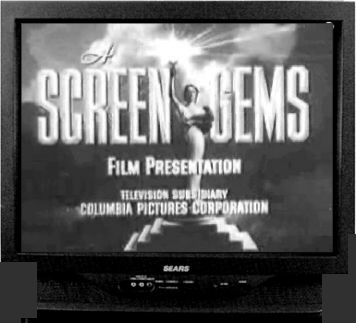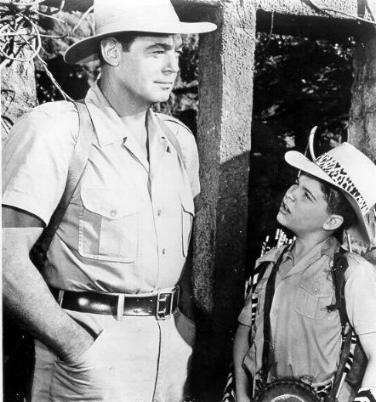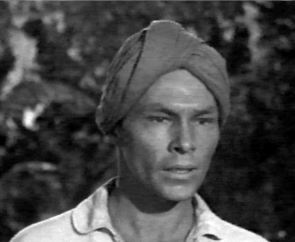

Advertised as a top flight action series shown in 158 cities in the US, and 38 countries worldwide, Jungle Jim, the TV series, in retrospect, was cheaply produced and designed to capitalize on its star’s audience appeal.
In 1954, the screen rights to the Jungle Jim character were turned over to Columbia’s subsidiary, Screen Gems, where producer, Harold Greene (1916-2000), was given the opportunity to do for television, what Sam Katzman had done for the movie theatre. And to echo the critics, he went one better than the Columbia producer, by lowering the budgets even more, and using as much stock footage as possible. And when Johnny Weissmuller completed his final film for Columbia, he did the TV series for Screen Gems. It says something for Weissmuller’s staying power that the series lasted as long as it did. It was never designed for prime time, and went almost immediately into syndication, but kept the jungle king clothed and fed for several more years.
The agreement was made between Sam Katzman’s Clover Productions and the William Morris Agency, and was reaffirmed in January 1955. The former Tarzan was to make a series of pictures based on the character Jungle Jim to be exhibited on television. As part of the agreement, it was understood that if Weissmuller did not appear in more than four episodes of the proposed series, none of these would be combined to form a feature film to be released theatrically.
Donald McDougall directed most of the episodes, the first four being directed by up-and-coming director, Earl Bellamy.
Contract player Norman Fredric (real name Frederick J. Foote) (1924-1999) was cast as the Hindu manservant, friend and confidant, Kaseem. Fredric often played an American Indian in series like Rin, Tin, Tin, and would later star as Steve Canyon, in the 1958-59 TV series of his own. He also appeared on Circus Boy, The Deputy, Laramie, The Lawman, Bronco, Surfside Six, Rawhide and The Rifleman. His rare foray onto the big screen arena saw him star in a cheaply made Sci-Fi film titled The Phantom Planet (61) under the name Dean Fredericks.
Young Martin Huston played Weissmuller’s son, Skipper.
Born in Lexington, Kentucky, Marty had a short TV career, starting out as the title character in My Son Jeep (1953) and in 1959 he had a regular role in Too Young to Go Steady. Other appearances included an episode of The Inner Sanctum (1954) , This Property Is Condemned on the Kraft Theatre (1958), Diagnosis Unknown (1960), and in an episode of Way Out, titled “Side Show” (1961). In 1970, he also appeared in an episode of Lancer. He made his Broadway debut in 1959 in “Only in America.” His theatre credits include “Take Her, She's Mine, ” “Come Blow Your Horn, ”and “A Race of Hairy Men.” He also portrayed the title role as Norman at the Lyceum Theatre in New York City in the play Norman, Is That You? in 1973. Cancer claimed his life in August 2001 at the age of 60.
Tamba was also brought back, played by a chimp named Neal of the World Jungle Compound, and trained by Howard Bryant. And Paul Cavanagh made several appearances as Commissioner Morrison. This was his first appearance with Weissmuller since Tarzan and His Mate.
Marty's mother, Marcella, recalls that her son and the chimp were the best of friends, playing like kids during breaks, and the simian was very protective of him. In one scene, a villain is supposed to grab Skipper from the bushes. The chimp left its trainer and ran up the villain’s back pounding him on his helmut., frightening the poor actor portraying the villain.
Bellamy recalled an amusing incident in the opening episode “Man Killer,” in which the chimp was to fire a rifle. The trainer was to work with the chimp for a week, getting him used to picking the weapon up and firing it. To play safe on the day they were to shoot the scene, Bellamy had the trainer remove the chimp from the sound stage while the weapon was being loaded. Then the animal was brought back to do the scene. But the moment he picked up the rifle to fire it, the animal went berserk. He ended up in the rafters of the stage... he had smelled the gunpowder. Using some deft editing, the scene was salvaged.
Unlike the majority of the films, the TV series used black actors to portray Africans, although the Jungle Jim character did visit other continents as well (mainly to make use of Asian jungle stock footage). Each episode lasted approximately 25 minutes, and involved Jim in a mystery, or in helping natives against evil white men. Often, a theme involved teaching son Skipper a lesson. To help him travel, Jim had a plane named The Sitting Duck.
Chicken Rock at Lake Sherwood was used for the series’ opening credits , with stuntman Paul Stader diving for Johnny. Jungle Jim’s compound and much of the close-up foliage was on a studio sound stage inside a bank. Bellamy recalls that some jungle scenes were filmed over at the MGM backlot, which still boasted its own jungle and river.
Occasionally, footage from the film series was borrowed, such as in the episode titled “Lagoon of Death,” in which scenes from The Lost Tribe and Fury of the Congo helped pad the 25 minutes. And the docudrama I Married Adventure provided the plot for one or two episodes, such as “Wild Man of the Jungle.”
When the series played out, Weissmuller’s career as an actor was over. The now defunct Nostalgia Channel resurrected the series for a time, and episodes are occasionally made available to enthusiasts by video companies.
Unlike many TV series, The Jungle Jim Show was copyrighted, and Columbia continues to hold television licensing rights until at least 2006.
Variety’s Review Oct. 5, 1955
In the [opening] episode are Dick Rich and Don Blackman, shown on KTTV Mon. 7 p.m. 30 minutes
Johnny Weissmuller has come by the sobriquet of “Mr Jungle” honestly enough, and this new series, with the kids at least, will nail down the title for another season at least. Here he is back among the beasts and the chimps (on the Columbia lot in Burbank). The small fry should continue to take to his escapades.
Being slotted in the “childrens' hour,” the ingredients are now pretty well standard. Weissmuller, long-time “Tarzan,” is dimensionally a heroic figure, even though he's not what could be called a thespic giant. Surround him with a pair of youngsters and a pet monkey, with generous library of wild animals at play, and the end result is a child's delight, even if childish entertainment.
The production is superior to most such adventure vidpix and the casting is properly characteristic. While “Jungle Jim” leads off the four hour parade of filmed actioners on KTTV Monday nights, it can't help the others. The audience it picks up will be lost when the kids are put away in the sack. (Helm)

Weissmuller with Martin Huston as son Skipper

Norman Fredric as Kaseem